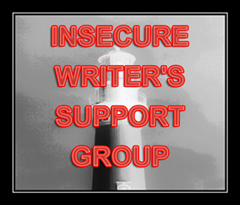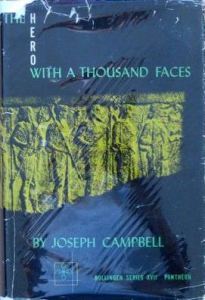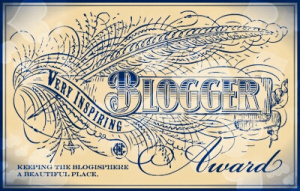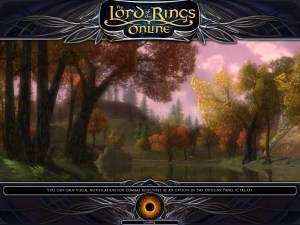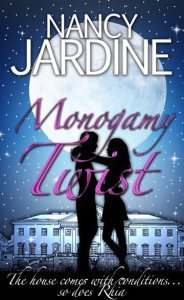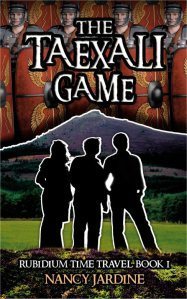Roland Clarke's Blog, page 60
April 7, 2015
F is for First Nations
The War of 1812 was a turning point for the First Nations, being the last conflict in north-eastern North America in which their participation was important, if not critical.
The peace treaty of 1783, which concluded the American Revolution, saw the ceding of all lands west of the Ohio River to the United States. However, the British still saw the Indian nations as valuable allies and a buffer to its Canadian colonies and they provided them with arms. Attacks on American settlers in the Northwest further aggravated tensions between Britain and the United States, and was one of the causes of the War of 1812.
In 1812 the Shawnee chief Tecumseh gathered 10,000 warriors, hoping to unify First Nations peoples into a confederacy with their own land and government. Tecumseh sided with the British not because he trusted them, but because he saw them as the lesser of two evils.
With the British fighting Napoleon Bonaparte in Europe, their troops in North America were stretched and the participation of native warriors was key to their campaign. However, First Nations warriors preferred to rely on stealth and spontaneous attack. They were puzzled and sometimes appalled by European tactics and by the extreme casualties the Europeans seemed to countenance. And the advocates of European tactics were unable to understand First Nation tactics, although they often turned the tide of battles.
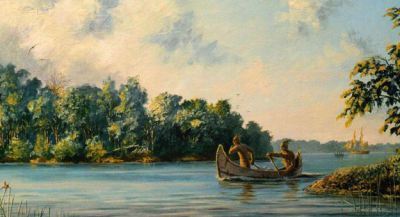
Just prior to the British capture of Fort Detroit, communications across the Detroit River were all-important. Fast canoes manned by loyal First Nations warriors performed this task (Downriver Despatches by Peter Rindlisbacher).
The First Nations were largely responsible for the fall of Michilimackinac on 17 July 1812, and subsequent victories. However, due to the inefficiency of the British commander at Moraviantown, the brunt of the fighting fell to the First Nations and they were routed and Tecumseh was killed. His loss is hard to overestimate and with him went the remains of the nativist movement. Nevertheless, First Nations warriors continued to fight until the end of the war.
During negotiations for the Treaty of Ghent, the British did try to bargain for the establishment of an Indian Territory but the Americans resolutely refused to agree. The most that they would accept was the status quo before the war. But despite all their efforts, the First Nations were unable to recover their lost territory.
Three years after the death of Tecumseh, Indiana became a state and began to remove all First Nations from their traditional lands, a mass eviction that was repeated in state after state. In the South East, the Creek War came to an end, and about half of the Creek territory was ceded to the United States, with no payment made to the Creeks. This was, in theory, invalidated by Article 9 of the Treaty of Ghent, thereby restoring to the Indians “all the possessions, rights and privileges which they may have enjoyed or been entitled to in 1811.” The British failed to uphold this, and did not take up the First Nations cause as an infringement of an international treaty. Without this support, the Indians’ lack of power was apparent and the stage was set for further incursions of territory by the United States in subsequent decades, such as the forced removal of the Choctaw and Cherokee under the Indian Removal Act of 1830.
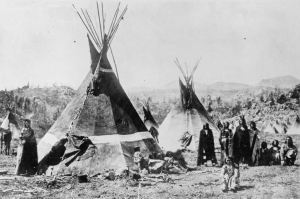
Indian Removal Act 1830. A tragic time in American history that led to the long forced relocation of Indigenous Americans on what is appropriately called the “Trail of Tears”.
In Canada, the War of 1812 was the end of an era in which the First Nations had been able to keep their positions in return for service in war. Soon, with the growth of Upper Canada, the First Nations were outnumbered in their own lands. It was almost forgotten that if not for their support Upper Canada might very well have fallen into American hands.
In 1992, Georges Erasmus, Chief of the Assembly of First Nations, said, “You have a phrase called “Golden Age.” We do not want to be depicted the way we were, when we were first discovered in our homeland in North America. We do not want museums to continue to present us as something from the past. We believe we are very, very much here now, and we are going to be very important in the future.”
http://www.thecanadianencyclopedia.ca/en/article/first-nations-in-the-war-of-1812/
http://www.eighteentwelve.ca/?q=eng/Topic/9
PREVIOUS A TO Z POSTS:
A is for Anishinaabe ~ B is for Brock ~ C is for Coloured Corps ~ D is for Detroit ~ E is for Erie
The brainchild of Arlee Bird, at Tossing it Out, the A to Z Challenge is posting every day in April except Sundays (we get those off for good behaviour.) And since there are 26 days, that matches the 26 letters of the alphabet. On April 1, we blog about something that begins with the letter “A.” April 2 is “B,” April 3 is “C,” and so on. Please visit other challenge writers.
My theme is ‘The War of 1812’, a military conflict, lasting for two-and-a-half years, fought by the United States of America against the United Kingdom of Great Britain and Ireland, its North American colonies, and its American Indian allies. The Memoirs of a British naval officer from the war is central to my novel “Seeking A Knife” – part of the Snowdon Shadows series.
Further reading on The War of 1812:
http://www.eighteentwelve.ca/?q=eng
http://www.theglobeandmail.com/globe-debate/the-war-of-1812-stupid-but-important/article547554/

April 6, 2015
E is for Erie
The Battle of Lake Erie, sometimes called the Battle of Put-in-Bay, was fought on 10 September 1813, in Lake Erie off the coast of Ohio during the War of 1812. In the first unqualified defeat of a British naval squadron in history, U.S. Captain Oliver Hazard Perry led nine vessels of the United States Navy to victory, capturing six vessels of the Royal Navy.
However, six of the American vessels were gunboats, small vessels that mounted only a single gun. Only two, the Lawrence and the Niagara, were full-size ships with an armament of two long guns and 18 carronades each.
One of the biggest naval battles of the War, it was closely contested for hours, and early in the battle, the British were taking a heavy toll on the American ships, principally because the British cannons were much more accurate at long distances. Perry’s flagship Lawrence was reduced to a defenceless wreck.

Perry’s Victory, painted by William Henry Powell of Cincinnati in 1865, illustrates Oliver Hazard Perry making his way from his severely damaged flagship, the Lawrence , in a rowboat through enemy fire to the Niagara The painting is currently hanging in the rotunda of the Ohio Statehouse.
He then transferred to the Niagara, which before Perry’s arrival had hardly engaged the British fleet. Now, Perry sailed the Niagara directly into the British lines, inflicting heavy cannon fire on the enemy ships. The commander of every British ship was killed or wounded, leaving the British ships under the command of junior officers with limited experience.
Perry took advantage of this situation. The Niagara rammed the British lead ship while the sailors fired rifles at the British seamen. By nightfall, the British had surrendered to Perry, who was only twenty-seven years old. Perry had won a complete victory at the cost of 27 Americans killed and 96 wounded; British casualties were 40 dead and 94 wounded. The surviving British crews, including the wounded, numbered 306.
After the battle, Perry sent a famous dispatch, written in pencil on the back of an old envelope, to U.S. General William Henry Harrison that read, “We have met the enemy, and they are ours.”
The Battle of Lake Erie cut off the British supply lines and forced the British to abandon Detroit, ensuring U.S. control over Lake Erie and the territorial northwest. It also paved the way for General Harrison’s attack on the British and Native American forces at the Battle of the Thames.
http://en.wikipedia.org/wiki/Battle_of_Lake_Erie
http://www.battleoflakeerieart.com/battle.php
http://www.ohiohistorycentral.org/w/Battle_of_Lake_Erie?rec=476
http://battleoflakeerie-bicentennial.com/history/the-battle/
PREVIOUS A TO Z POSTS:
A is for Anishinaabe ~ B is for Brock ~ C is for Coloured Corps ~ D is for Detroit
The brainchild of Arlee Bird, at Tossing it Out, the A to Z Challenge is posting every day in April except Sundays (we get those off for good behaviour.) And since there are 26 days, that matches the 26 letters of the alphabet. On April 1, we blog about something that begins with the letter “A.” April 2 is “B,” April 3 is “C,” and so on. Please visit other challenge writers.
My theme is ‘The War of 1812’, a military conflict, lasting for two-and-a-half years, fought by the United States of America against the United Kingdom of Great Britain and Ireland, its North American colonies, and its American Indian allies. The Memoirs of a British naval officer from the war is central to my novel “Seeking A Knife” – part of the Snowdon Shadows series.
Further reading on The War of 1812:
http://www.eighteentwelve.ca/?q=eng
http://www.theglobeandmail.com/globe-debate/the-war-of-1812-stupid-but-important/article547554/


April 5, 2015
Bill Allen: A Great Heart and A Generous Man

Bill Allen at Borde Hill Horse Trials ~ Photo by Tony Warr
On Saturday April 4th the sport of eventing lost one of its great supporters and personalities, Bill Allen. My first thought was for his wife Ann, and his family as I know how close they all are.
I couldn’t help it but I cried. For me Bill was special, as a friend and a colleague. Without Bill, I would never have got Borde Hill Horse Trials back onto the calendar. As my co-organiser, Bill taught me everything I know about running a horse trials, and helped assemble a first class team to put on the event. For many Bill was a first-class starter, and the joint-organiser of the successful Purston Horse Trials, but he could turn his hand to almost everything. But most important thing I learnt was that the organiser was responsible for chucking out the rubbish bags.

Bill Allen at Borde Hill Horse Trials with BE Steward Nicky Salmon (centre), Johnny Hill and Roland Clarke (right). Photo by Tony Warr.
There have been so many tributes to him, and they all say, “how helpful and supportive of many events and people he was”. That he was “such a hard working lovely man, always with a joke and a smile and will be SO missed”. We “will miss his cheerful banter and big smile!”
Of course for me Borde Hill Horse Trials wasn’t the beginning as I already knew Bill. He was one of the linchpins at so many events that I attended, initially as a journalist, and then as co-ordinator of the South East Eventers League. In fact the SEEL organisers made sure to honour Bill & Ann for their crucial work ‘behind the scenes’, by presenting them with the Seahorse Achievement Award in 1998. And, of course, Ann was an integral part of the partnership – and of any event she scored or helped at.

The Seahorse Achievement Award
Bill continued to support me as life got harder because of my multiple sclerosis, making sure that provision was always made for my disability. He ensured, with the two main sponsors Johnny Hill and Bill Kear, that I had a mobility scooter to continue going to events. However, MS eventually took its toll and I had to give up as co-organiser at Borde Hill, but although he too stood down, Bill Allen still helped the new team.
As my MS got worse, I went to fewer events, but tried to go to at least one Borde Hill event each year. And one of the first people to greet me was Bill Allen, even if he was busy doing things to keep the event running smoothly. Sadly, 2013 was the last time I went to the Horse Trials at Borde Hill, as we moved to Wales in 2014. So that was the last time that I saw Bill & Ann Allen.
So I wasn’t aware that he had cancer, or that during Tweseldown Horse Trials in March, Ann was visiting him in hospital ever evening, after working at the event.
Eventing has lost a great supporter and friend. I just feel devastated. My love and condolences to Ann and to all his family.
R.I.P Bill Allen, a great heart and a generous man.
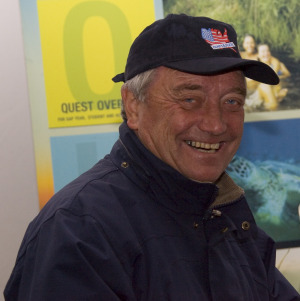
Photo by Tony Warr
.
R.I.P Bill Allen, a great heart and a modest man.


April 4, 2015
D is for Detroit
On July 12, 1812, General William Hull led an invading American force of about 1,000 untrained, poorly equipped militia across the Detroit River and occupied the Canadian town of Sandwich (now a neighbourhood of Windsor, Ontario).
During the War of 1812, the Detroit River served as a major barrier between the American Michigan Territory and British Upper Canada, especially during the Battle of Fort Detroit in August 1812, when Detroit briefly fell to the British.
The Siege of Detroit, also known as the Surrender of Detroit, or the Battle of Fort Detroit, was an early engagement in the War of 1812. A British force under Major General Isaac Brock with Native American allies under the Shawnee leader, Tecumseh, used bluff and deception to intimidate the American Brigadier General William Hull into surrendering the fort and town of Detroit, Michigan, and a dispirited army (numbering 2,500 with the addition of 500 Canadians), although they outnumbered the victorious British and Native Americans (330 regulars, 400 militia, and 600 First Nations).
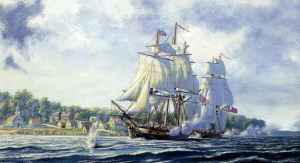
‘Bombardment Of Fort Detroit, 1812 by Peter Rindlisbacher.’
The American loss was considerable: some 2188 men, 39 guns, and a large store of shot, flint, and powder. The surrender not only cost the United States the village of Detroit, but control over most of the Michigan Territory.
The British victory reinvigorated the militia and civil authorities of Upper Canada, who had previously been pessimistic and affected by pro-American agitators. Many Native American people in the Northwest Territory were inspired to take arms against American outposts and settlers.
The British held Detroit for more than a year before their small fleet on Lake Erie was defeated, which forced them to abandon the western frontier of Upper Canada,
But that will be my Monday post, as E is for Erie.
http://www.eighteentwelve.ca/?q=eng/Topic/14
http://en.wikipedia.org/wiki/Siege_of_Detroit
http://www.historyofwar.org/articles/battles_detroit.html
http://www.warof1812.ca/batdetroit.html
PREVIOUS A TO Z POSTS:
A is for Anishinaabe ~ B is for Brock ~ C is for Coloured Corps
The brainchild of Arlee Bird, at Tossing it Out, the A to Z Challenge is posting every day in April except Sundays (we get those off for good behaviour.) And since there are 26 days, that matches the 26 letters of the alphabet. On April 1, we blog about something that begins with the letter “A.” April 2 is “B,” April 3 is “C,” and so on. Please visit other challenge writers.
My theme is ‘The War of 1812’, a military conflict, lasting for two-and-a-half years, fought by the United States of America against the United Kingdom of Great Britain and Ireland, its North American colonies, and its American Indian allies. The Memoirs of a British naval officer from the war is central to my novel “Seeking A Knife” – part of the Snowdon Shadows series.
Further reading on The War of 1812:
http://www.eighteentwelve.ca/?q=eng
http://www.theglobeandmail.com/globe-debate/the-war-of-1812-stupid-but-important/article547554/

April 3, 2015
C is for Coloured Corps
Shortly after the Americans declared war on the British in June 1812, a 68 year old West African named Richard Pierpoint proposed the formation of a Black fighting unit, a “Corps of men of Colour.” A small militia unit was formed and became known as the Coloured Corps. Pierpoint, who had fought for the British in the American Revolutionary War, was one of over 50 who served in that unit throughout the war. While the commanding officers were white, six of the enlisted Black men served as sergeants or corporals and the rest served as privates. The number strength of the unit varied throughout the war due to fatalities, illness, desertions and the occasional addition of Black soldiers from other militias. There were usually between 25-30 men. The Coloured Corps saw action in some of best-known battles of the War of 1812. At the Battle of Queenston Heights, they participated in the recapture of the Redan Battery after the death of Major General Brock.
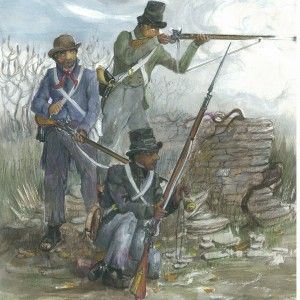
Coloured Corps Painting
“Runchey’s Coloured Corps” by Cameron Porteous.
Image courtesy of canadianartcards.com. 1812 1 20N.
The Black population throughout British North America had much to fear, should the Americans win the war: those who were free men might find themselves sold into slavery. Those who were enslaved might have hoped that their service to the King as soldiers would win them their freedom.
There were both free and enslaved men in the Coloured Corps’ ranks. While Pierpoint gained his freedom for his service in a British provincial regiment, Butler’s Rangers, he was one of many who were free men when the Corps was founded. Robert Scott, a free man and farmer living in the town of York, joined up. George Martin, another Coloured Corps enlistee, had been a slave as a child, until his freedom was purchased by his own father who, like Pierpoint, had served in Butler’s Rangers.
However, others were not so lucky. “Jack” was a slave who had enlisted in the Coloured Corps, perhaps believing that by doing so he might gain his freedom. He was owned by a white slaveholder, W. A. Nelles, who requested that the military return “Jack” to him in March 1814. Prince Henry was the legal property of William Jarvis, the Provincial Secretary of Upper Canada. He appears on the muster roll in 1813. Was he signed up by Jarvis, or was he a ‘run-away,’ hoping his military service would gain him his freedom?
The Coloured Corps was a unique fighting unit within the British military, consisting of men who valued freedom and who were willing to fight to ensure freedom for themselves, their families and their country.
In 1813, the company was transformed into a unit of the Provincial Corps of Artificers and attached to the Royal Sappers and Miners. It served on the Niagara front during the war, and was disbanded a few months after the war ended.
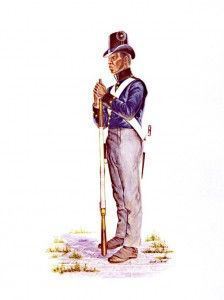
1814 Corps of Artificiers. Image courtesy of Parks Canada.
The Coloured Corps was dismissed in March of 1815, a few months after the signing of the Treaty of Ghent. In the years following the war, Coloured Corps veterans worked hard at getting back pay and their pensions. The records indicate that these claims were still being settled well into the 1820s and early 1830s. In fact, getting what was owed was often left to their widows and children, as many Coloured Corps veterans died before receiving what was due to them.
The unit’s history and heritage is perpetuated in the modern Canadian Army by the Lincoln and Welland Regiment.
Further Information:
http://tubman.info.yorku.ca/educational-resources/war-of-1812/richard-pierpoint/coloured-corps/
http://en.wikipedia.org/wiki/Captain_Runchey%27s_Company_of_Coloured_Men
http://www.eighteentwelve.ca/?q=eng/Topic/25
http://www.pbs.org/wned/war-of-1812/essays/black-soldier-and-sailors-war/
The brainchild of Arlee Bird, at Tossing it Out, the A to Z Challenge is posting every day in April except Sundays (we get those off for good behaviour.) And since there are 26 days, that matches the 26 letters of the alphabet. On April 1, we blog about something that begins with the letter “A.” April 2 is “B,” April 3 is “C,” and so on. Please visit other challenge writers.
My theme is ‘The War of 1812’, a military conflict, lasting for two-and-a-half years, fought by the United States of America against the United Kingdom of Great Britain and Ireland, its North American colonies, and its American Indian allies. The Memoirs of a British naval officer from the war is central to my novel “Seeking A Knife” – part of the Snowdon Shadows series.
Further reading on The War of 1812:
http://www.eighteentwelve.ca/?q=eng
http://www.theglobeandmail.com/globe-debate/the-war-of-1812-stupid-but-important/article547554/

April 2, 2015
B is for Brock
Major-General Sir Isaac Brock KB (6 October 1769 – 13 October 1812) was a British Army officer and administrator, who was assigned to Lower Canada in 1802. Despite facing desertions and near-mutinies, he commanded his regiment in Upper Canada (present-day Ontario) successfully for many years. He was promoted to major general, and became responsible for defending Upper Canada against the United States. While many in Canada and Britain believed war could be averted, Brock began to ready the army and militia for what was to come. To this end he oversaw improvements to the fortifications at Quebec and improved the Provincial Marine which was responsible for transporting troops and supplies on the Great Lakes. Though appointed brigadier general in 1807 by Governor General Sir James Henry Craig, Brock was frustrated by a lack of supplies and support.
However, he worked to alter the militia act to expand his forces and began building relationships with Native American leaders such as the Shawnee chief Tecumseh, and nations such as the Anishinaabe. Brock felt that British military fortunes were bleak. In Upper Canada, he possessed only 1,200 regulars which were supported by around 11,000 militia. As he doubted the loyalty of many Canadians, he believed only around 4,000 of the latter group would be willing to fight. Despite this outlook, when the War broke out, the populace was prepared, and quick victories at Fort Michilimackinac and Detroit defeated American invasion efforts.
Brock’s actions, particularly his success at Detroit, earned him a knighthood, membership in the Order of the Bath, accolades and the sobriquet “The Hero of Upper Canada”.
Brock died at the Battle of Queenston Heights. Leading two companies of the 49th Regiment and two companies of York militia, he charged up the heights assisted by aide-de-camp Lieutenant Colonel John Macdonell. In the attack, Brock was struck in the chest and killed, as was his aide who died in a second charge. However the battle was eventually a British victory. [Q will be for Queenston]
Twelve years after Brock’s death, a 130 foot stone monument was erected in his honour on the heights near the spot where he was killed. His remains, as well as those of Macdonell, were reburied beneath the monument in an elaborate ceremony attended by many of his contemporaries. In 1840, the monument was destroyed by a massive blast of gunpowder, ignited by an American sympathizer. The monument was subsequently rebuilt in 1856, 52 feet taller than before. Today, the monument, which now straddles the longest undefended border in the world, remains one of the most imposing historical landmarks in Canada. Relics of Brock’s career can be seen at the Canadian War Museum in Ottawa, where his bullet-pierced tunic is prominently on display.
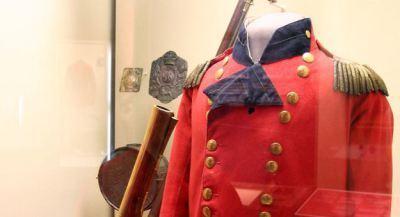
The coat worn by Major General Sir Isaac Brock at the time of his death at Queenston Heights on 13 October 1812. On display at the Canadian War Museum, the bullet hole is evident under the lapel (courtesy Archives of Ontario/S1427)
http://www.eighteentwelve.ca/?q=eng/Topic/16
http://en.wikipedia.org/wiki/Isaac_Brock
http://www.warof1812.ca/brock.htm
The brainchild of Arlee Bird, at Tossing it Out, the A to Z Challenge is posting every day in April except Sundays (we get those off for good behaviour.) And since there are 26 days, that matches the 26 letters of the alphabet. On April 1, we blog about something that begins with the letter “A.” April 2 is “B,” April 3 is “C,” and so on. Please visit other challenge writers.
My theme is ‘The War of 1812’, a military conflict, lasting for two-and-a-half years, fought by the United States of America against the United Kingdom of Great Britain and Ireland, its North American colonies, and its American Indian allies. The Memoirs of a British naval officer from the war is central to my novel “Seeking A Knife” – part of the Snowdon Shadows series.
Further reading on The War of 1812:
http://www.eighteentwelve.ca/?q=eng
http://www.theglobeandmail.com/globe-debate/the-war-of-1812-stupid-but-important/article547554/

April 1, 2015
A is for Anishinaabe
For the first day of my A to Z Challenge, I resisted choosing the arena for the War of 1812 – America. But first what caused the conflict? Unsettled issues between the British and the United States after the War of Independence were a factor, as was the Royal Navy attempting to press gang American sailors. However, the US also thought that American settlers in the territory that would become Canada would support their invasion across the border. Canada then consisted of the maritime colonies and parts of southern Quebec and Ontario. But let’s start with the First Nations, who were the other major players on both sides.
A is for the Anishinaabe (Ojibwe, Odawa, Potowatomi), who were among two dozen tribal nations that were involved in the conflict.
When war was declared, there were 8,410 warriors of the Western Confederacy, who included Ojibwe, Odawa, Potowatomi, Huron, Shawnee, Mississaugas, Nipissings and Algonkians. The Anishinaabe made up 7,410 of this number, an overwhelming majority. Although the Shawnee war chief Tecumseh is most associated with the war, it was the Anishinaabe that formed the majority.
The tribes met for military and political purposes and maintained relations with fellow Anishinaabeg nations (Mississauga, Algonquin, and Nipissing) from Michilimackinac, an island between Lake Huron and Lake Michigan, It’s always been revered, although opinion is divided whether it is because the island is the turtle of creation or the place of origin of the spirits now called Bgoji-anishnaabensag.
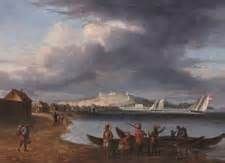
Mackinac Island, William Dashwood – A Painting Commissioned by Robert McDouall
Major General Brock, aware that there were not enough regular forces available to defend Upper Canada, suggested that capturing Michilimackinac and Detroit, from the US, would allay the suspicions of the natives who no longer trusted the British after the Battle of Fallen Timbers in 1796. The chiefs constantly recalled when the Americans overpowered the Western Confederacy and the British abandoned the retreating Anishinaabeg to massacre, by locking the gates to Fort Miami.
When Brock’s forces fought alongside the Anishinaabe to secure Fort Michilimackinac, many more of the western nations joined the British.
Throughout the war, the Anishinaabe were repeatedly told that their interests would not be forgotten when peace was made. So much so that at the conclusion of the War of 1812, the Odawa suggested that the British negotiators offer the Americans a greater quantity of Anishinaabe land on the mainland in order to keep Michilimackinac in their possession.
The possibility was there, but in the end the British meekly vacated Michilimackinac to the United States. It is totally conceivable that at least a portion of upper Michigan or Wisconsin could have been set aside as an “Indian country” as the British had promised. The mechanisms were in place but not the honour. This is why the Anishinaabeg say that “we did not lose the war but we lost the peace”.
Further reading on the Anishinaabe and the War of 1812:
http://activehistory.ca/tag/anishinaabeg/
http://activehistory.ca/2014/09/anishnaabeg-in-the-war-of-1812-more-than-tecumseh-and-his-indians/
http://en.wikipedia.org/wiki/Anishinaabe
http://www.theworldofgord.com/2012/11/heritage-toronto-talk-anishinaabe-first.html
The brainchild of Arlee Bird, at Tossing it Out, the A to Z Challenge is posting every day in April except Sundays (we get those off for good behaviour.) And since there are 26 days, that matches the 26 letters of the alphabet. On April 1, we blog about something that begins with the letter “A.” April 2 is “B,” April 3 is “C,” and so on. Please visit other challenge writers.
My theme is ‘The War of 1812’, a military conflict, lasting for two-and-a-half years, fought by the United States of America against the United Kingdom of Great Britain and Ireland, its North American colonies, and its American Indian allies. The Memoirs of a British naval officer from the war is central to my novel “Seeking A Knife” – part of the Snowdon Shadows series.
Further reading on The War of 1812:
http://www.eighteentwelve.ca/?q=eng
http://www.theglobeandmail.com/globe-debate/the-war-of-1812-stupid-but-important/article547554/

Myth Creation
Today, Wednesday 1st April is the moment that sees great events collide – and for some that means never believe anything – there could be a prank lurking.
For me this is the first day of the Blogging from A to Z (April 2015) Challenge, the monthly Insecure Writers Support Group post, and the day when submissions open at Crooked Cat – very relevant as I am an avid Cat reader with dozens of their books on my Kindle.
After all the valuable comments from my beta readers, and the involvement of my excellent editor, Sue Barnard, I intend to be submitting “Storms Compass”, the first part of my “Gossamer Flames” saga. Whether it is suitable remains to be seen.
LATEST NEWS ON APRIL 3rd: I have decided that I will not be submitting “Storms Compass” to Crooked Cat, as (a) it is not suitable due to the overt fantasy/shamanic aspect; (b) it still needs a stronger overarching plot-line with the distinct protagonist and antagonist appearing more; (c) it’s too short still at 45,600 words..
On to IWSG and today’s insecurity – or rather an insecurity that’s been told to wait in the garden. Many experts talk about the right arcs/stages to make a novel work – and the wrong ones. Which method do you use?
I’ve been looking at my WIPs to see if the stages are in the right place. I admit that I am a plotter, but I structure as the story unfolds in my head, then scrawl notes, and then make an outline/guideline. But I don’t use arcs or stages to work anything out – when the story reaches 25% it moves on of its own accord. No forceful persuasion.
And my first drafts, especially the most recent? They are, without consciously plotting them that way, following those prescribed arcs. Why?
I recollect that Joseph Campbell, in Hero with a Thousand Faces, mentioned the ancient story tellers and how their plots were structured. He termed it the monomyth and found it in most world mythology.
Is there something in a storyteller’s makeup that allows us to instinctively weave a plot that works? Perhaps the process matures over time, the more tales we read, watch or write. How did the writers of the classics achieve this without the guidance that we have in the 21st century? Or is that where the Muses come in?
All Nine often used to come to me, I mean the Muses:
But I ignored them: my girl was in my arms.
Now I’ve left my sweetheart: and they’ve left me,
And I roll my eyes, seeking a knife or rope.
But Heaven is full of gods: You came to aid me:
Greetings, Boredom, mother of the Muse.
Epigram 27 * Venetian Epigrams (1790)
Johann Wolfgang von Goethe (28 August 1749 – 22 March 1832)
That epigram or poetic observation had a significance for Goethe that is shared by one of my characters in “Seeking A Knife”, the second novel in the Snowdon Shadows series, and at present it is positioned before the tale begins. It could even be significant that the Venetian Epigrams were published in 1790, so available to any well-bred gentleman that fought in the War of 1812, like the naval officer whose Memoirs play such a key role in “Seeking A Knife”.
As for my A to Z Challenge post, that follows once you have recovered.
***
Purpose of the IWSG day: To share and encourage. Writers can express doubts and concerns without fear of appearing foolish or weak. Those who have been through the fire can offer assistance and guidance. It’s a safe haven for insecure writers of all kinds!
Posting: The first Wednesday of every month is officially Insecure Writer’s Support Group day. Post our thoughts on our own blog. Talk about our doubts and the fears we have conquered. Discuss our struggles and triumphs. Offer a word of encouragement for others who are struggling. Visit others in the group and connect with our fellow writers – aiming for a dozen new people each time. Let’s rock the neurotic writing world!
Our Twitter hashtag is #IWSG
Alex Cavanaugh’s awesome co-hosts for the April 1 posting of the IWSG are Suzanne Furness,Tonja Drecker, Toi Thomas, Rachna Chhabria, Fundy Blue, and Donna Hole!

March 26, 2015
The Very Inspiring Blogger Award
I’m beginning to catch up after a hectic month attempting to address all the comments on “Storms Compass” that I got back from my brave beta readers. I tried to address all the points, even if some didn’t feel right – until I gave them proper consideration and explored them fully. Today I passed this first Book in the Gossamer Flames saga to my editor friend Sue Barnard.
Now it’s time to address the nomination that I received a few weeks ago for Very Inspiring Blogger Award, from talented Italian friend, Sarah Zama.
Sarah is a wonderful jeweller and a budding writer so I recommend visiting her blog, The Old Shelter, which has a fascinating collection of articles, stories and links. I liked her jewellery so much that I bought a steampunk pendant for my wife.

Steampunk Heart from JazzFeathers
Anyway, on to today’s task. In order to accept the award, I have to do a few things:
Display the award on your blog.
Link back to the person who nominated you.
State 7 things about yourself.
Nominate 15 bloggers, link to them, and notify them about their nominations.
7 Things about me
Having been interviewed a few times, these are the more obscure facts.
1. Although I sound English, was born in England and most of the time went to school in England, I am actually a quarter Chilean. My mother was born in Chile to a Chilean mother and an English father. Although my grandmother lived near us and spoke Spanish with my mother, I didn’t learn the language from them. But I had an ear for it, so with the right encouragement I learnt enough to survive.
2. The only time that I didn’t go to school in England, was when I was in Canada. For two years I did my GCSE A levels at Bransons, a school in the Laurentians, north of Montreal. Think I spent as much time skiing as I did studying. Suspect that my French – learnt at school in England – didn’t improve as Quebecois felt like a different language; in fact it evolved from Breton French. I also spent a further year living in Toronto, the city that I vowed never to visit. Never make rash statements. I was intending to train as a journalist, but the Canadian system didn’t recognise my A levels. So I spent a year doing a General Studies course that was a step back in some respects. But it turned me green and into a vegetarian.
3. While in Canada, I went on a white-water expedition. The Beaver River trip took a few weeks and entailed the first navigation of this river from The Yukon to British Columbia – by white skins. Don’t ask how many times I tipped the rubber raft over.
4. I may live in Wales now, with a view of the mountains and the sea, but I have no Welsh blood – just second cousins that grew up here. I can claim a touch of Celtic blood though, as some of my ancestors were from Scotland, and proudly wore the Grant tartan. But I speak more words of Welsh than Gaelic.
5. [Thanks to Sara for this one] “I was a Tolkien fan way before the Lord of the Rings movie trilogy came out.”
In fact, “Lord of the Rings” is the book that influenced me most as a writer, and I re-read it when I can. It has always headed my list of favourite books and has always inspired me whether I need to escape into another world or in my writing. Is that the same thing? And I have been able to see my vision of Middle Earth on screen plus been there in a gaming world. I also have the hardback set that I read in my late teens back in the late 1970’s. Strange fact is that it was not the first Tolkien piece of writing that I devoured – that was his lecture paper “”Beowulf: The Monsters and the Critics”, followed by “Tree and Leaf”, which contains the essay ‘On Fairy Stories’, which Sara Zama says, “any writer should read…Tolkien says it takes a lot more than dragons and magic to make a fantasy story. Magic has to be part of that world, it has to be woven in its very fabric to the point you can’t imagine that world without that kind of magic. And that world with that magic has to have the intimate consistency of reality.”
6. I hate roller-coasters to the point that I once bit my ex-wife on the shoulder because I was terrified on some runaway train at Disneyland. No that wasn’t why she left me for a better man. I also tried to throw myself out of a rickety big wheel that had nothing holding us in – except a useless bar. Is there a murder mystery there? Funfair Fiasco?
7. I worked for a few years in the TV/film industry, losing a lot of money trying to make a movie in Malta. During that time, I worked with a few amazing people ranging from Doctor Who actors like Jon Pertwee and Tom Baker, to musicians like Keith Emerson (Emerson, Lake & Palmer) and my best friend Steve Hackett (Genesis).

Image courtesy of FreeDigitalPhotos.net
And now comes the hardest part, choosing the fifteen blogs to nominate. Apologies if you have been nominated, don’t accept nominations, got missed out, or even wonder if I actually know anybody.
http://nancyjardine.blogspot.co.uk/
https://ashleighgalvin.wordpress.com/home/
http://broad-thoughts-from-a-home.blogspot.co.uk/
https://vanessacouchmanwriter.wordpress.com/
http://alexjcavanaugh.blogspot.co.uk/
http://mark-patton.blogspot.co.uk/
http://wendyswritingnow.blogspot.co.uk/
http://theequestrianvagabond.blogspot.co.uk/
https://awomanswisdom.wordpress.com/
http://elizabethducie.blogspot.co.uk/
Next port of call/task on the To Do list is a new page on this site, called ‘Snowdon Shadows’ and those book reviews that have never got written. Oh and there’s A to Z, IWSG, and so much more.

March 24, 2015
A visit from Nancy Jardine
I’m really pleased to welcome my friend and fellow writer Nancy Jardine to my Writing Wings blog. She’s a true Celtic writer whereas I only live in a Celtic land further south. Please tell you about your new releases, Nancy.
Hello Roland, I’m totally delighted that you’ve let me come to share my new launch news with your readers.
Those who already know me a little will have learned that my writing spans the fiction sub-genres of historical romantic adventures; contemporary romantic mysteries; and time travel adventures for a middle grade/YA market. My next two books to hit the launch pad are from these quite different styles of writing – though both were delightful to create!
I’m very excited that on the 27th March 2015, Crooked Cat Publishing is re-launching a new general reading edition of Monogamy Twist, a light-hearted contemporary romantic mystery. The fabulous quirky new cover, designed by Laurence Patterson of Crooked Cat, reveals a grand house at the centre of the story which is a really excellent image since the plot is based around a Dickensian theme. Luke Salieri finds he’s been bequeathed a dilapidated mansion in Yorkshire…but he can only fully inherit after some weird and antiquated stipulations are fulfilled! He’s never met his benefactress; hasn’t even heard of her but Luke’s never one to back down from a challenge. He needs expert help, though, to find out why Amelia Greywood chose him and Rhia Ashton seems ideal. Rhia, a historian and family tree researcher, seems perfect but it turns out that she has her own ideas of what will make Luke’s strange request worthwhile. Compromise is the name of the game for Luke…and for Rhia.
It’s probably no surprise that the plot for the novel came about as a combination of my watching the current BBC TV Charles Dickens serial of late 2010 and while I was also doing the first forays in researching my own ancestral background. I found a decided black sheep in one of my great-grandfathers: Rhia finds a good few family surprises for Luke in Monogamy Twist! Rhia and Luke were lovely characters to invent but some readers have told me that they love Thor, the Irish wolfhound, even more!
I extend a warm welcome to your readers to join my Facebook Launch Party for Monogamy Twist on the 27th March 2015. Quirky goodies can be won. There’ll be music; food; lovely locations in Yorkshire… Why not pop in and say hello!
https://www.facebook.com/events/1092788957413601/
PRE-ORDER AVAILABLE NOW FROM AMAZON:
My other new launch – The Taexali Game, a time travel historical adventure for a middle grade/ YA readership − will be in April 2015. Set in northern Roman Britannia (current Aberdeenshire) in AD 210, my valiant trio – Aran, Brian and Fianna – must work through a set task list, part of which is to help both the ‘baddies’ and the ‘goodies’ in the story. The problem is that there are local Celtic tribespeople who are just as nasty as the invading Roman Emperor Severus and his barbaric son Caracalla. Working out who to trust is a perilous business. Literally sparring with death is a daily occupation back in AD 210, but in The Taexali Game, my teens are up to the challenges facing them! Graphic designer, Neil Saddler, has done a fabulous job of blending the main elements of the story in the wonderful cover design he’s created for me − depicting locally recognised background scenery in Aberdeenshire; the threat of invasion from the Ancient Roman Legions; my time trio who are about to launch themselves into the adventure! The Taexali Game will be available in both paperback and ebook formats.
 Nancy Jardine
lives in Aberdeenshire, Scotland. She currently shares a home with her husband, daughter, son-in-law, 3 year old granddaughter and 1 year old grandson. It’ll continue to be a busy household till late summer of 2015 when the new build home will be completed for the young ‘uns on what was Nancy’s former back garden. The loss of that part of the garden won’t be missed since there should now be more writing time available this spring and summer! Childminding is intermittent over the day and any writing time is precious. (If interested in how a new house is built these days, follow my blog posts named ‘Gonna build a house’ )
Nancy Jardine
lives in Aberdeenshire, Scotland. She currently shares a home with her husband, daughter, son-in-law, 3 year old granddaughter and 1 year old grandson. It’ll continue to be a busy household till late summer of 2015 when the new build home will be completed for the young ‘uns on what was Nancy’s former back garden. The loss of that part of the garden won’t be missed since there should now be more writing time available this spring and summer! Childminding is intermittent over the day and any writing time is precious. (If interested in how a new house is built these days, follow my blog posts named ‘Gonna build a house’ )
All matters historical are a passion; Ancestry research a lovely time-suck. Nancy regularly blogs and loves to have guests visit her blog. Facebooking is a habit she’s trying to keep within reasonable bounds! Any time left in a day is for leisure reading and the occasional historical series on TV.
Author links:
http://nancyjardine.blogspot.co.uk http://nancyjardineauthor.com/ Twitter @nansjar Facebook: http://on.fb.me/XeQdkG
Amazon Author page for books and to view book trailer videos:
US http://amzn.to/RJZzZz UK http://www.amazon.co.uk/Nancy-Jardine/e/B005IDBIYG/ref=ntt_dp_epwbk_0
Novels also available from Barnes and Noble; W.H. Smith; Waterstones.com; Smashwords; TESCO Blinkboxbooks; and various other places.
Thank you for the opportunity to share my news with your readers!
A pleasure to have you visit. And for those that missed my review of Nancy’s “Topaz Eyes”, read the Goodreads review here.


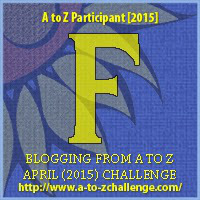
![A2Z-BADGE-000 [2015] - Life is Good](https://i.gr-assets.com/images/S/compressed.photo.goodreads.com/hostedimages/1428092352i/14364582.jpg)
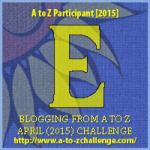
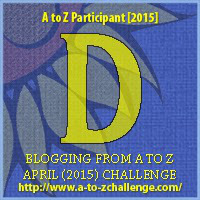
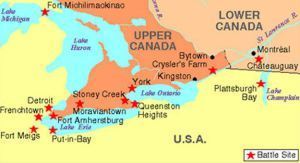
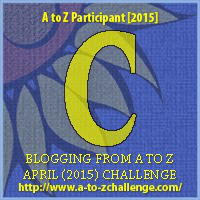
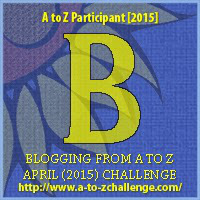
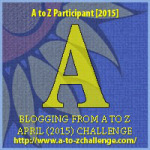
![A2Z-BADGE-000 [2015] - Life is Good](https://i.gr-assets.com/images/S/compressed.photo.goodreads.com/hostedimages/1428150839i/14376920.jpg)
